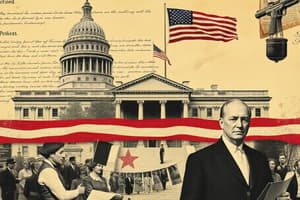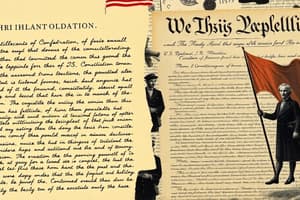Podcast
Questions and Answers
What was the first written constitution called?
What was the first written constitution called?
Articles of Confederation
Under the United States' first constitution, there was a president.
Under the United States' first constitution, there was a president.
False (B)
Under the Articles of Confederation, the relationship between the states and the federal government can be best compared to what?
Under the Articles of Confederation, the relationship between the states and the federal government can be best compared to what?
the United Nations
What was the primary concern of the Articles of Confederation as a constitution?
What was the primary concern of the Articles of Confederation as a constitution?
Under the Articles of Confederation, it was left to the __________ to execute the laws passed by Congress.
Under the Articles of Confederation, it was left to the __________ to execute the laws passed by Congress.
When were the Articles of Confederation adopted?
When were the Articles of Confederation adopted?
What was the purpose of the Annapolis Convention?
What was the purpose of the Annapolis Convention?
What was Shays's Rebellion an attempt to do?
What was Shays's Rebellion an attempt to do?
Where was the 1787 convention to draft a new constitution held?
Where was the 1787 convention to draft a new constitution held?
Which was the only state not to send delegates to the Constitutional Convention?
Which was the only state not to send delegates to the Constitutional Convention?
Why was Shays's Rebellion significant?
Why was Shays's Rebellion significant?
What did the Virginia Plan propose for the national legislature?
What did the Virginia Plan propose for the national legislature?
What did the New Jersey Plan propose for Congress?
What did the New Jersey Plan propose for Congress?
What did the Great Compromise lead to?
What did the Great Compromise lead to?
What does bicameralism mean?
What does bicameralism mean?
Who did James Madison believe was at conflict during the Constitutional Convention?
Who did James Madison believe was at conflict during the Constitutional Convention?
What is the Three-fifths Compromise?
What is the Three-fifths Compromise?
Which of the following was a ramification of the Three-fifths Compromise?
Which of the following was a ramification of the Three-fifths Compromise?
What is the system of shared powers between a central government and the states called?
What is the system of shared powers between a central government and the states called?
Why is only one-third of the Senate up for re-election during any single election year?
Why is only one-third of the Senate up for re-election during any single election year?
What is judicial review?
What is judicial review?
What is the term length of a federal judge?
What is the term length of a federal judge?
To amend the Constitution requires a __________ vote by Congress, and approval by __________ of the states.
To amend the Constitution requires a __________ vote by Congress, and approval by __________ of the states.
What does the supremacy clause state?
What does the supremacy clause state?
During the ratification debates, who were the Anti-federalists?
During the ratification debates, who were the Anti-federalists?
In the national debate over ratification of the new Constitution, what did the Federalists support?
In the national debate over ratification of the new Constitution, what did the Federalists support?
What did the Federalists believe was the most apparent source of tyranny?
What did the Federalists believe was the most apparent source of tyranny?
How did the Anti-federalists argue that the powers of government should be limited?
How did the Anti-federalists argue that the powers of government should be limited?
How did the Federalists believe that the powers of government could be limited?
How did the Federalists believe that the powers of government could be limited?
Flashcards are hidden until you start studying
Study Notes
The Articles of Confederation
- The first written constitution of the United States was the Articles of Confederation, adopted in 1777.
- There was no executive branch; specifically, no president existed under this first constitution.
- The Articles created a loose alliance between states, similar to the structure of the United Nations.
Governance and Limitations
- The Articles primarily aimed to limit the powers of the central government.
- States were responsible for executing laws passed by Congress, leading to inconsistencies in law enforcement.
- The government under the Articles was deemed inefficient, as evidenced by Shays's Rebellion, which highlighted weaknesses in governance.
Conventions and Reforms
- The Annapolis Convention was convened to address the weaknesses of the Articles.
- The 1787 Constitutional Convention, held in Philadelphia, aimed to draft a new constitution; Rhode Island was the only state not represented.
Plans and Compromises
- The Virginia Plan proposed representation in the national legislature based on state population or revenue.
- The New Jersey Plan advocated for equal representation among states, irrespective of size.
- The Great Compromise resulted in a bicameral Congress, balancing representation concerns.
Slavery and Representation
- The Three-fifths Compromise counted three out of every five slaves for representation and taxation purposes, enshrining slavery in the constitutional framework.
- This compromise facilitated political agreements between northern and southern states while mitigating conflicts between agricultural and merchant interests.
Federalism and the Senate
- Federalism describes the shared powers between state and central government.
- One-third of the Senate faces re-election each year, designed to maintain stability against sudden political changes.
Judicial Powers
- Judicial review empowers courts to evaluate the constitutionality of actions by other government branches.
- Federal judges serve life terms, subject to impeachment, ensuring judicial independence.
Constitutional Amendments
- Amending the Constitution requires a two-thirds vote in both congressional chambers and ratification by three-fourths of the states.
- The Supremacy Clause establishes that the Constitution and federal laws prevail over state laws.
Ratification Debates
- Anti-federalists opposed the new Constitution, favoring a weaker central government, while Federalists supported a strong national framework.
- Federalists viewed the majority's power as the primary source of tyranny, advocating for systemic checks and balances within government.
- Anti-federalists sought to limit governmental powers through the addition of a Bill of Rights to safeguard individual liberties.
Studying That Suits You
Use AI to generate personalized quizzes and flashcards to suit your learning preferences.




